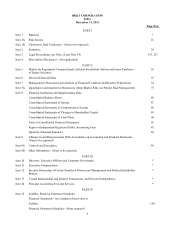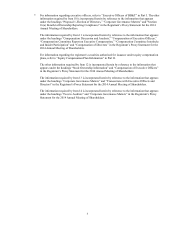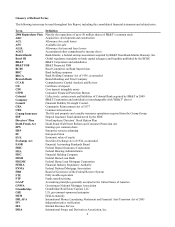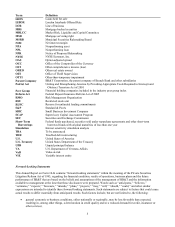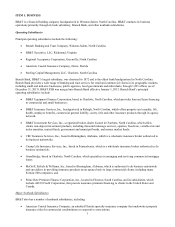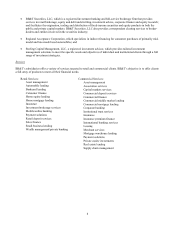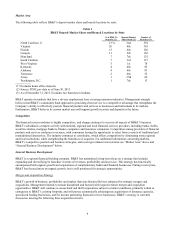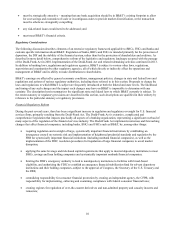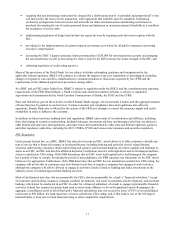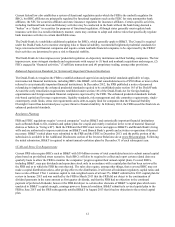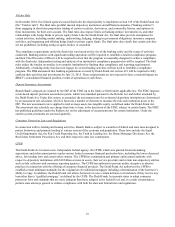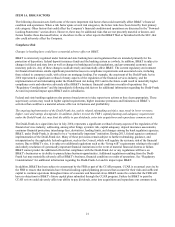BB&T 2013 Annual Report Download - page 12
Download and view the complete annual report
Please find page 12 of the 2013 BB&T annual report below. You can navigate through the pages in the report by either clicking on the pages listed below, or by using the keyword search tool below to find specific information within the annual report.
12
Current federal law also establishes a system of functional regulation under which the FRB is the umbrella regulator for
BHCs, but BHC affiliates are principally regulated by functional regulators such as the FDIC for state nonmember bank
affiliates, the SEC for securities affiliates and state insurance regulators for insurance affiliates. Certain specific activities,
including traditional bank trust and fiduciary activities may be conducted in the bank without the bank being deemed a
“broker” or a “dealer” in securities for purposes of functional regulation. Although states generally must regulate bank
insurance activities in a nondiscriminatory manner, states may continue to adopt and enforce rules that specifically regulate
bank insurance activities in certain identifiable areas.
The Dodd-Frank Act establishes additional regulation for BHCs, which generally apply to BB&T. The Council is required
under the Dodd-Frank Act to monitor emerging risks to financial stability, recommend heightened prudential standards for
large, interconnected financial companies and require certain nonbank financial companies to be supervised by the FRB if
their activities are determined to pose a risk to financial stability.
The Dodd-Frank Act also imposes new prudential regulation on depository institutions and their holding companies. The law
imposes new, more stringent standards and requirements with respect to (1) bank and nonbank acquisitions and mergers, (2)
FHCs engaged in “financial activities,” (3) affiliate transactions and (4) proprietary trading, among other provisions.
Enhanced Supervision Standards for Systemically Important Financial Institutions
The Dodd-Frank Act requires the FRB to establish enhanced supervision and prudential standards applicable to large,
interconnected financial institutions, including BHCs like BB&T, with total consolidated assets of $50 billion or more (often
referred to as systemically important financial institutions). In December 2012, the FRB published a notice of proposed
rulemaking to implement the enhanced prudential standards required to be established under section 165 of the Dodd-Frank
Act and the early remediation requirements established under section 166 of the Dodd-Frank Act for foreign banking
organizations and foreign nonbank financial companies supervised by the FRB. The enhanced prudential standards include
risk-based capital and leverage requirements, liquidity standards, risk management and risk committee requirements, single-
counterparty credit limits, stress test requirements and a debt-to-equity limit for companies that the Financial Stability
Oversight Council has determined pose a grave threat to financial stability. In February 2014, the FRB issued the final rule on
enhanced prudential standards.
Resolution Planning
FRB and FDIC regulations require “covered companies” such as BB&T and systemically important financial institutions
such as Branch Bank to file, maintain and update plans for a rapid and orderly resolution in the event of material financial
distress or failure (a “living will”). Both the FRB and the FDIC must review and approve BB&T’s and Branch Bank’s living
wills and are authorized to impose restrictions on BB&T’s and Branch Bank’s growth and activities or operations if deemed
necessary. BB&T’s initial plans were submitted to the FRB and the FDIC in December 2013, and the public portion of the
submission is available in the Additional Disclosures section of the Investor Relations site at www.bbt.com/about. Following
the initial submission, BB&T is required to submit annual resolution plans by December 31 of each subsequent year.
CCAR and Stress Test Requirements
Current FRB rules require BHCs such as BB&T with $50 billion or more of total consolidated assets to submit annual capital
plans based on pre-defined stress scenarios. Such BHCs will also be required to collect and report certain related data on a
quarterly basis to allow the FRB to monitor the companies’ progress against their annual capital plans. Covered BHCs,
including BB&T, may pay dividends and repurchase stock only in accordance with a capital plan that has been reviewed by
the FRB and as to which the FRB has not objected. The rules also require, among other things, that a covered BHC may not
make a capital distribution unless, after giving effect to the distribution, it will meet all minimum regulatory capital ratios and
have a ratio of Basel I Tier 1 common capital to risk-weighted assets of at least 5%. BB&T submitted its 2013 capital plan for
review in January 2013 and was notified by the FRB in March 2013 that the FRB did not object to the continuation of
dividend payments in the same amount as first quarter dividends, and that the FRB had no objection to the continued
payment of preferred dividends; however the FRB did object to certain other elements of BB&T’s capital plan which were
unrelated to BB&T’s capital strength, earnings power or financial condition. BB&T submitted a revised capital plan to the
FRB in June 2013 and the FRB subsequently notified BB&T in August 2013 that it had no objection to the revised capital
plan.


